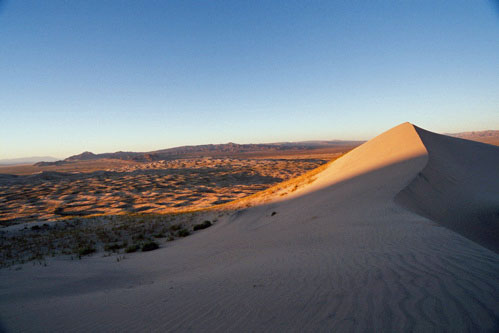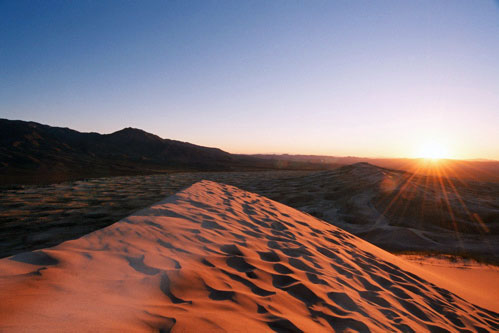Love the Mojave
I turned the car off the Interstate in Eastern California with a line from Fear and Loathing in Las Vegas running through my head: “We were twenty miles outside of Barstow when the acid began to take hold.” We were a bit more than twenty miles outside of Barstow, I gave up on acid a long time ago, and although my boyfriend kept saying the line over and over again, it turns out that’s not the real quote at all. Still, there’s something about wheeling through the desert somewhere between the sticky streets of Los Angeles and the vapid spread of Las Vegas - something about that ambiguous state line between organic California and nuclear Nevada that made me wish for the simple salvation of hallucinogenic drugs.
I was on the last leg of a post-college grand tour, trading in the more traditional Eurail for a white 1996 Mercury Grand Marquis, and a London-Paris-Rome itinerary for one that read more like Peoria-Reno-Long Beach. It was the road trip I was supposed to have as part of my American childhood, except my parents hated driving. In the September after graduating from college, I took matters into my own hands.
Like most rash decisions, this trip was about a lot more than Milk Duds and audio books. It was no less than my solution to the dilemma of post-modern tourism. As evidenced by the proliferation of companies offering “immersion experiences,” books advertising “authentic destinations,” and water-cooler conversations in which the most valued travel experiences are those considered to be “off the beaten path,” the dilemma of postmodern tourism is that very few travelers want to be labeled as tourists anymore. Myself included.
I went to Eastern Europe armed with history books, and East Africa toting texts in local cuisine. I avoided wearing sneakers in France. I traveled a lot in college, and I was continually obsessed with being a different kind of traveler, and especially with having more knowledge of the place I was going.

My habit of reading before traveling was culturally sensitive, and ultimately exhausting. With this road trip, I wanted to make a radical break with my sensitive past. I wanted to give up on the idea of not being a tourist, and just be a tourist. I wanted to wear a fanny pack, carry two cameras, talk too loudly, and know nothing about the place I was going. I wanted to stop worrying and love travelling.
It probably would have been a great time, but I relapsed after less than a week. Somewhere in the Black Hills of South Dakota I picked up a book of area history, and before long I had become self-conscious again. I had begun to consider myself somehow superior to the legions of elderly tourists that stepped off of tour buses in the parking lots that ring the Mount Rushmore National Monument. My descent back into post-modern tourism included a particular embarrassing near-death experience in Badlands National Park, as I teetered on the edge of a crumbling mud spire, trying to commune with spirits who probably wanted nothing to do with me.
This behavior continued all the way through the Rocky Mountains, into California, and down the coast. By the time we left Los Angeles, I had dragged my travel companion (and soon-to-be-ex boyfriend) from one absurd venture to the next, always refusing to do anything on a tourist itinerary. One day in San Francisco, he finally just went to Alcatraz by himself while I sat in a park and mused on vernacular Victorian architecture.
I had again become worried. Worried about the greater implications of tourism, about the meaning of travel - worried that I might be the kind of tourist I despised.
This explains how I wound up, one day in early October, with a commandeered Mercury Grand Marquis and a cranky boyfriend, exiting Interstate-40, heading towards a piece of land nestled into a triangle made by the I-15, I-40, and the Nevada border.
We were going to the Mojave National Preserve, part of the much larger and more notorious Mojave Desert. We had driven through the greater Mojave on the way to California; it covers most of Nevada, as well as parts of Eastern California and Western Utah. The Mojave Desert is the Mojave of American lore, of the X-Files, and of nuclear refuse. Most of it is pretty inaccessible, fenced off from the side of the road and usually far too close to a military reserve or base to make getting out of the car particularly comfortable. The Nevada Mojave has a way of making you paranoid, and I spent most of it clinging to the interior of the car.

But the 1.5 million acres of the National Preserve must have been considered valuable enough at one time to be pried from the talons of the Bureau of Land Management (an amorphous, ambiguous government organization) and placed into the nurturing, educational bosom of the National Park Service. Despite its occasional appearance in NPS literature, the Mojave didn’t seem to have much that a tourist would want to see. Which, of course, is why I was there.
The Mojave intrigued me because it was empty, because it was silent, and because no one else wanted to be there. Despite my best efforts to embrace Mount Rushmore, the Mojave fed my roots as an anti-tourist tourist. It was the sort of place where I could suffer under the satisfying illusion that I saw beauty where other people saw only emptiness.
So, delaying the debauchery of Las Vegas, I exited the highway onto a secondary route and followed it to the turnoff for the preserve. The National Preserve looks more or less like the rest of the Mojave, with a sagebrush rug and occasional larger cacti running along flat plains and up the sides of dry mountains. The only place to really hike in the preserve is at the Kelso Sand Dunes, which can be reached by anyone in a car by driving about forty miles into the protected area along a paved road, and following a gravel access road three miles further. People don’t seem to do it often; the only other souls in the parking area - in fact, the only other people encountered after leaving the highway - were a German couple in an imported RV changing from hiking boots into sandals, without taking off their socks.
As we began to hike, the dunes loomed closer. They were anachronistic, golden lumps piled on raggedy desert. It didn’t look far to the highest point, but there was a visual deception. Each dune seemed to expand laterally into the distance during ascension. Logically, I suppose it was just a product of sand hiking, which is the least productive activity known to outdoor enthusiasts. At least half of every ventured step was lost, as almost every grain of sand my foot displaced skidded downhill, towards the car.
We continued to hike, and I began to realize why people die in the desert. On an intellectual plane it’s not particularly difficult to understand, but respirating at a level that almost made me want to quit smoking, I began to feel a little desperate. Almost too desperate to look for snakes, although I saw pervasive evidence of sidewinders. In some sort of delusional bargain with the unseen reptiles, I avoided stepping on their tracks, part of my defense should an encounter come to fists against fangs.
By the time we were halfway up, the footprints that were scattered among the lower elevations of the dunes were gone—it was just us, and two other sets of tracks (I’d bet money that those belonged to the Germans). I was trying very hard to take this as a sign of my own endurance, rather than an indication of my foolishness.
It’s difficult to describe how steep the climb became towards the end, but suffice it to say that as my hands were plunged into the side of the dune, I clung like a sidewinder to the contours of the sand hills. In a triumphant moment, I sunk my fingers into the end of the ridge and swung one leg over the side, where I could half-shimmy, half walk up the ridge to the coveted vista.
The sun was setting as I crawled up to meet my companion, who had either grown less cranky or was just having a harder time expressing it through his panting. From the top of the highest dune, there was a pretty decent view. Just desert for miles and miles – not a single tourist, not a single car. There was one road, visible down the other side of the dunes, but no one was on it. I had never been anywhere so silent; perhaps it’s a cliché of the desert, but it seemed like the sand or the mountains or something was just sucking up all the sounds. It was a little disorienting to be so close to Los Angeles, so close to Las Vegas, and so far from any sign of human habitation.

The emptiness was, of course, why I had insisted we go the dunes in the first place. Despite my resolve to be a tourist this time, I was back to my old tricks: avoiding the beaten path, dressing to blend in, and trying to learn something about a place through reading. I was sorely disappointed in my own penchant for circular self-examination. I didn’t quite know what had gone wrong.
Hiking in the desert is the definition of tourism in the same way that swimming with dolphins is the definition of relating to animals. No one hikes in the desert—doing so is beyond absurd, a comedic death march. Add sand to the equation and it is almost science fiction.
What crippled my relationship with travel was not that I was always a tourist, although I was, or that I had been taking the process of traveling too seriously, although I had. The crippling thing was the idea, held by so many people I knew, that tourism itself is bad, that there are somehow two or three distinct methods of traveling, with tourism being akin to skinning cat with a spoon. The crippling thing was my refusal to believe that there was any meaning in tourism. Traveling is tourism, no matter how it is stylized. Travelers who seek the obscure remain tourists, even off the beaten path. Our mistake has been to assume there is no meaning in the simple act of touring,
It was just lovely from the top of the dune. It was nothing more than foolish to climb up there, but it was very nice. And silent and empty and spacious and dry and all the adjectives that do not describe the Northeastern United States, which was really the point. The point was not to know the rainfall of Southern Wyoming or the number of cattle in Northern Arizona. The point was not to stubbornly set myself apart from other visitors by acquiring books and maps. The point was just to do something different. I departed to find the solution to post-modern tourism; I think now that maybe traveling should be kept away from any semblance of post-modern claws. I think I should stop worrying and love the Mojave.
